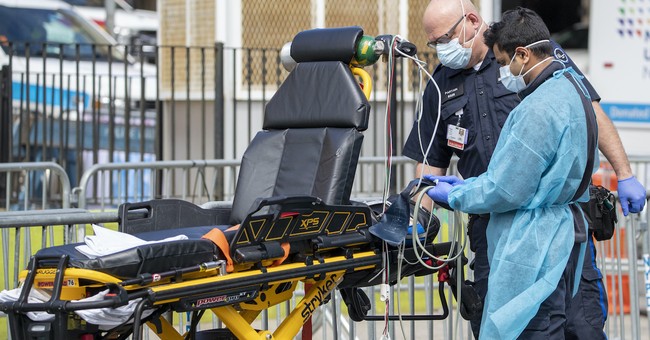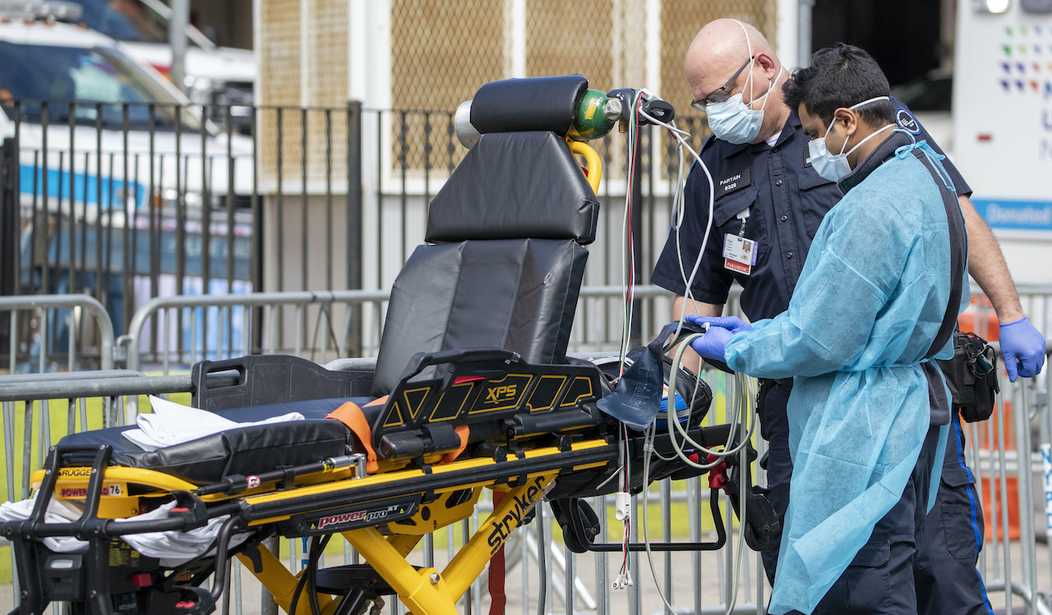
Emergency medical technicians disinfect their equipment after delivering a patient to Elmhurst Hospital Center, Saturday, April 4, 2020 in the Queens borough of New York. The new coronavirus causes mild or moderate symptoms for most people, but for some, especially older adults and people with existing health problems, it can cause more severe illness or death. (AP Photo/Mary Altaffer)
California has announced that it’s devised a system that judges who gets to live and who gets to die during a crisis based on their likelihood to survive it.
According to the LA Times, California has quietly created a document that details a plan it will follow in the event of a “worst-case scenario.” The 38-page document created by the California Department of Public Health talks of methods to keep hospital beds available for the sick and dying by rating who is likeliest to survive. This means that healthcare workers and young people get priority while those with serious chronic conditions would get shoved to the back of the line.
The CDPH’s director acknowledged that the plan is morbid and that it’s going to spark “difficult” conversations.
“As your state public health officer, the gravity of what is contained within this document is felt deeply,” wrote Dr. Sonia Angel. “The conversations that will be prompted by its release will be difficult.”
The decision on whether to treat a patient or not will boil down to a point system where the lower the score the more likely you are to be treated:
The scoring system would assess potential organ failure risk and the presence of life-limiting conditions to determine prognoses for hospital survival and longer-term survival. For example, major life-limiting chronic diseases, such as moderate Alzheimer’s disease or moderately severe chronic lung disease, would add two points to someone’s score. Chronic diseases likely to cause death within a year’s time, such as severe Alzheimer’s disease or severe chronic lung disease, could add four points.
Total scores would range from one to eight, with priority for ventilators given to those with lower scores. If there are not enough resources to treat all patients with the same score, the guidelines suggest hospitals group patients by age — ages 12-40, 41-60, 61-75 and older than 75 — and treat younger people first.
They call this grouping by age the “life-cycle principle,” or prioritizing the young so that they can live through the entire cycle of human life while those older have already gotten the chance to do so.
The document also states that those “vital to the public health response, including all those whose work directly supports the provision of acute care to others, should be given heightened priority.” In other words, doctors and nurses will be treated before others as their capacity to help would be more valuable. The same principle can be seen on airplanes where you’re instructed to put your oxygen mask on before your child’s.
It would be horrifying to find out you have too many points during a crisis to be treated, but would your tune change in the midst of a crisis when hospital beds are few and far between? Would it anger you to learn your sick child couldn’t be treated because elderly people not likely to survive are taking up the beds or would you believe that if there’s a chance they could survive then they deserve the care?
It’s an interesting ethical dilemma to ponder and a subject that’s likely to escalate into a public debate very soon.















Join the conversation as a VIP Member